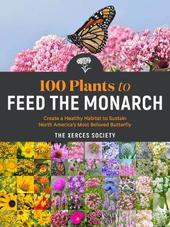
|
100 Plants to Feed the Monarch: Create a Healthy Habitat to Sustain North America's Most Beloved Butterfly
Paperback / softback
Main Details
| Title |
100 Plants to Feed the Monarch: Create a Healthy Habitat to Sustain North America's Most Beloved Butterfly
|
| Authors and Contributors |
By (author) The Xerces Society
|
| Physical Properties |
| Format:Paperback / softback | | Pages:288 | | Dimensions(mm): Height 203,Width 152 |
|
| ISBN/Barcode |
9781635862737
|
| Classifications | Dewey:638.5789 |
|---|
| Audience | |
|---|
|
Publishing Details |
| Publisher |
Storey Publishing LLC
|
| Imprint |
Storey Publishing LLC
|
| Publication Date |
13 April 2021 |
| Publication Country |
United States
|
Description
This practical, inspiring guide shows how individuals can help support the endangered North American monarch butterfly, with information on creating monarch-friendly landscapes using plants that feed and sustain the butterfly through the different stages of its life. The plight of the monarch butterfly has captured public attention and sparked widespread interest in helping to save their dwindling populations. In this in-depth portrait of the monarch butterfly - covering its life cycle, its remarkable relationship with milkweed, its extraordinary migration, and the threats it now faces due to habitat loss and climate change - detailed instructions on how to design and create monarch-friendly landscapes are enriched by guidance on observing and understanding butterfly behavior and habits. Following the model of their previous best-selling book, 100 Plants to Feed the Bees, The Xerces Society provides at-a-glance profiles of the plant species that provide monarchs with nourishment. The plants, which are all commercially available, range from dozens of species of milkweed - the only food of monarch caterpillars - to numerous flowering plants, shrubs, and trees that provide nectar for the adult butterfly, including those that bloom in late season and sustain monarchs in their great migration. Gorgeous photographs of monarchs and plants, plus illustrations, maps, and garden plans, make this a visually engaging guide. AUTHOR: The Xerces Society is a nonprofit organization based in Portland, Oregon, that protects wildlife through the conservation of invertebrates and their habitat. Established in 1971, the Society is at the forefront of invertebrate protection worldwide, harnessing the knowledge of scientists and the enthusiasm of citizens to implement conservation programs. They are the authors of 100 Plants to Feed the Bees, Farming with Native Beneficial Insects, and Attracting Native Pollinators.
Author Biography
The Xerces Society is a nonprofit organization based in Portland, Oregon, that protects wildlife through the conservation of invertebrates and their habitat. Established in 1971, the Society is at the forefront of invertebrate protection worldwide, harnessing the knowledge of scientists and the enthusiasm of citizens to implement conservation programs. They are the authors of 100 Plants to Feed the Bees, Farming with Native Beneficial Insects, and Attracting Native Pollinators.
Reviews"A treasure chest for gardeners... a brilliant and essential addition to everyone's monarch conservation library." -- Robert Michael Pyle, founder of the Xerces Society and author of Chasing Monarchs "The Xerces Society is a proven source of information on how we can help insects survive in our human-dominated world... from creating successful habitat to understanding the plants that feed monarch caterpillars and butterflies, this book has it all." -- Karen Oberhauser, director of the University of Wisconsin-Madison Arboretum "A handy guide for anyone who wants to create a pollinator-friendly garden. It's full of easy-to-understand information about endangered monarch butterflies and lots of beautiful photographs of the types of plants you should use to help them thrive." -- Los Angeles Times Gift Guide "In this in-depth portrait of the monarch butterfly... detailed instructions on how to design and create monarch-friendly landscapes are enriched by guidance on observing and understanding butterfly behavior and habits." -- Berkshire Eagle "These eye-opening tips will appeal to both seasoned conservationists and those new to the cause." -- PW
|